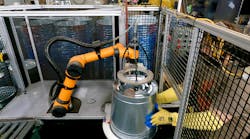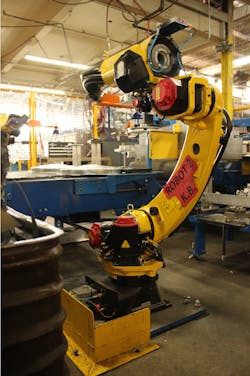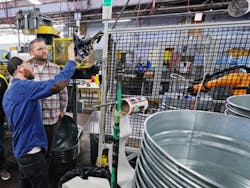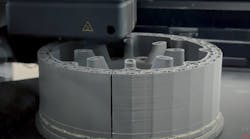Integrating robots into manufacturing may require long lead times, substantial capital investments, operator training and long-term maintenance plans if companies pursue purchase or lease plans. Or a manufacturer could embrace the robots-as-a-service (RaaS) model and let someone else worry about all the related logistics.
The best choice depends on what challenges a manufacturer wants to solve. Do you want to create entirely new processes based on the robot integration or integrate robots into existing processes?
Investing in all-new processes may revolve around the large, caged industrial robots familiar to many manufacturers. Smaller, collaborative robots (cobots) are well-suited for integration into existing processes. Costs and support options vary widely between those approaches.
Now, the buy/lease/RaaS question adds a whole new wrinkle on the financial side, regardless of what kind of robot and what nature of integration a manufacturer considers. With so many factors to consider, one size doesn’t fit all, and you end up with the most frustrating answer to any question: “Well, it depends.”
Behrens Metalware, based in Winona, Minnesota, faced all of these choices as it embraced robotics to address serious manufacturing challenges. The company deployed two very different and decidedly successful robot integrations by accepting the need to be flexible in how it deployed the technology.
Addressing Labor Concerns
Behrens considered robots for a long time owing to the high cost and general unavailability of labor; the desire to remove humans from dull, dirty and dangerous jobs; and the repeatable quality gains that go along with automation. Labor concerns ultimately forced the issue.
“The strategy [for deploying] these robots [concerns] one thing only and that’s to reduce our labor costs,” says Bill Bellingham, vice president of manufacturing at Behrens. His company manufactures simple metal goods including trash cans, pots and planters, requiring unskilled labor.
“Even with the shipping costs, our labor cost is five times higher than in Mexico,” Bellingham says.
Even if Behrens found the rates palatable, the company also couldn't find the employees it needed.
“We were 34 people short in the factory. And we were hiring people at a rate never seen before at Behrens. But it wasn’t at a rate fast enough,” Bellingham says. “Our hand was forced when we couldn’t get employees. We had to do something.”
Big Robots, Big Investments
Behrens purchased the centerpiece of the first project, a large industrial robot manufactured by Japanese automation giant Fanuc, from custom automation company Machine Concepts.
The robot alone represented a $1.5 million investment, a capital expenditure so large it required approval straight from the board of directors. The establishment of an entirely new plant operation made purchasing the robot attractive, however. This was a practically permanent installation.
“There was an option to lease [the industrial robot] but it’s through the manufacturer and there’s some risk for that manufacturer so their lease cost is higher. There’s the risk of us saying, ‘Hey, we don’t want this anymore, take it back.’ And they can do nothing with it. They don’t make pails. They can repurpose the robots, but that’s about it,” Bellingham says.
The integration plan included purchasing new machines for uncoiling, feeding, stamping and box sealing among other functions, to replace multiple, manual processes for trash can cover production. Planning for the new automation cell began in November 2020 and Machine Concepts finished integrating the cell in April 2022.
Behrens expects it will take two years for the Fanuc robot to pay for itself, after calculating the myriad, related factors.
“We tried to capture all of our expenses with the old process. Labor, downtime, scrap. $1.5 million for us as a company is a huge purchase. There’s a lot of analysis and detail that went into it, months and months and months of work,” Bellingham says.
The manual can cover production process required three people who produced approximately 2,000 covers per shift. The automated cell requires a single person to tend the process and produces around 3,000 covers per shift.
Renting Robots Pays Dividends Faster
Planning for the cobot-based integration began in December 2021. Rapid Robotics, based in San Francisco, installed the four cobots onto four separate production lines in April 2022, coincidentally the same month the industrial robot came online.
The cobots pierce holes on the side of a metal pail where the handle mounts. Rapid Robotics also provided a simple control system that runs off iPads and in two weeks completed an integration that Bellingham thinks would have taken three to four months to accomplish in-house.
“We pay for [each cobot] monthly just like we would an employee,” Bellingham says. “[Each] cobot is essentially the same cost as one person per shift.” The cobots may each run up to three shifts per day, however.
“After one shift, these things are making us money,” Bellingham says.
Line speeds did not increase once the cobots went into operation, but line pacing smoothed out.
“Before we put the cobot on the lines, there was nothing on the line that really held the cycle time for the employee, who kind of worked at their own pace,” Bellingham says. “Now, the cobot is pacing the line and runs at our set cycle time.”
Once the cycle time standardized, Behrens found that a single riveter couldn’t keep up and added a second person to the line. With these basic adjustments completed, throughput increased by approximately 10% and scrap fell around 12% on each of the four lines.
Who Owns Maintenance?
When weighing whether to buy or lease a robot, or embrace the RaaS model, consideration of ongoing support may play into the decision.
Owning the industrial robot requires Behrens to take responsibility for preventative and reactive maintenance. In November 2021, Behrens sent four operators to Fanuc headquarters in Chicago for one week of training, at a cost of several thousand dollars per operator, to learn how to program, troubleshoot and maintain the robot. Six team members also went to Machine Concepts for training on the operation of the entire automation cell.
The robot has only crashed once, after which Fanuc dispatched a technician to make the repair. Behrens covers everything else in-house.
Cobot maintenance and repair, on the other hand, lies entirely with Rapid Robotics. “We had issues with one of our cobot arms and Rapid overnighted us a new arm and had a technician here the same day it arrived,” Bellingham says. “They took one arm off and put the new one on at no additional cost to us.”
Robots Inspire Continuous Improvement
Integrating two very different kinds of robots into two very different plant operations drove home the potential benefits and varied uses for robotics at Behrens, which fuels enthusiasm for the technology.
“With any new technology there’s a lot of hesitation. ‘We don’t have this knowledge here. Do we really want to take on this risk?’ Once you put a couple robots in and they are successful, now there’s no risk involved, or less risk involved,” Bellingham says. “Back up three years ago, here at Behrens when you said the word ‘robot,’ it was kind of a scary term. Now when we talk about robots, it’s a positive discussion.”
The cobots in particular drive continuous improvement projects, such as automated label application on a pail manufacturing line. Each metal pail has two seams, and the product label must be placed between them. The cobots have to locate the seams in order to pierce at the correct positions.
Behrens recognized it could further leverage that positional data by adding automated label applicators downstream. The positional data is fed from the cobots to the label applicators, that provide neat, clean and consistent label placement.
Two of the cobots work on a line that may produce up to four different products. Behrens’ engineering team designed two “quick changeover blocks” that can slide on and off the line, designed to hold different products in similar locations to one another so as to minimize the need to reposition the cobot during changeovers.
“Bryce, our engineer, he has had a blast [doing projects like these]. He’s really embraced the technology. They’re like his cobots now,” Bellingham says.
Some operators still hesitate to embrace the technology out of fear that robots will replace humans on unskilled labor tasks.
“But anyone can run a cobot. It’s simple,” Bellingham says. “So, we’re working really hard to market that and tell our employees if they are interested in robots to get into them.”
The moral of the story: Don't let anyone try to convince you that a single robotics methodology can solve all your automation needs. Automation provides flexibility, so be flexible when planning your integrations.







